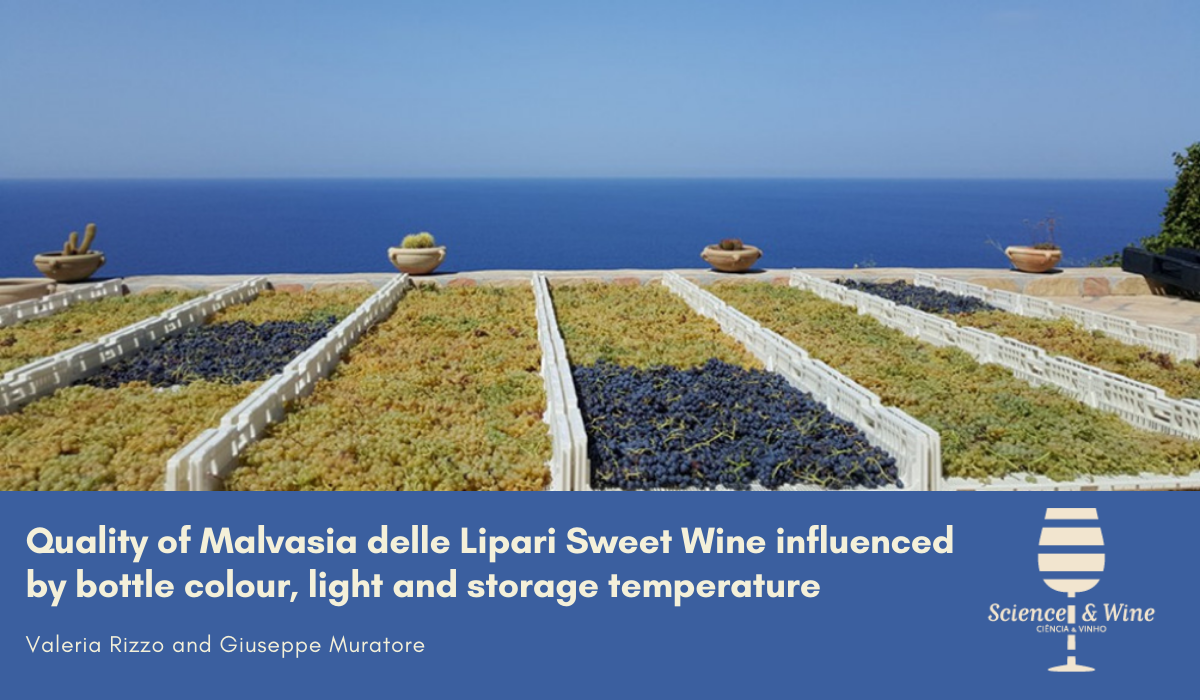The influence of light exposure, bottle color and storage temperature on the quality parameters of Malvasia delle Lipari (MdL) sweet wine were investigated. Wine samples bottled in clear-colored (colorless, green and amber) glass were stored under different artificial lighting conditions, in order to simulate the retail environment (one cool-white, fluorescent lamp) and to perform an accelerated test (four and six cool-white, fluorescent lamps). The storage temperature was kept constant (25 °C) for the first 90 days of the experiment and then samples were monitored for up to 180 days at higher temperatures (30, 35 and 40 °C). The principal enological parameters, total phenols, color, 5-hydroxymethylfurfural (HMF) and 2-furaldehyde (2F) contents were studied. The shelf-life test pointed out minimum variations of the basic chemical parameters, while the quality attributes most affected by lighting were color, together with HMF and 2F levels which, hence, can be considered as indicators of the severity of storage conditions.
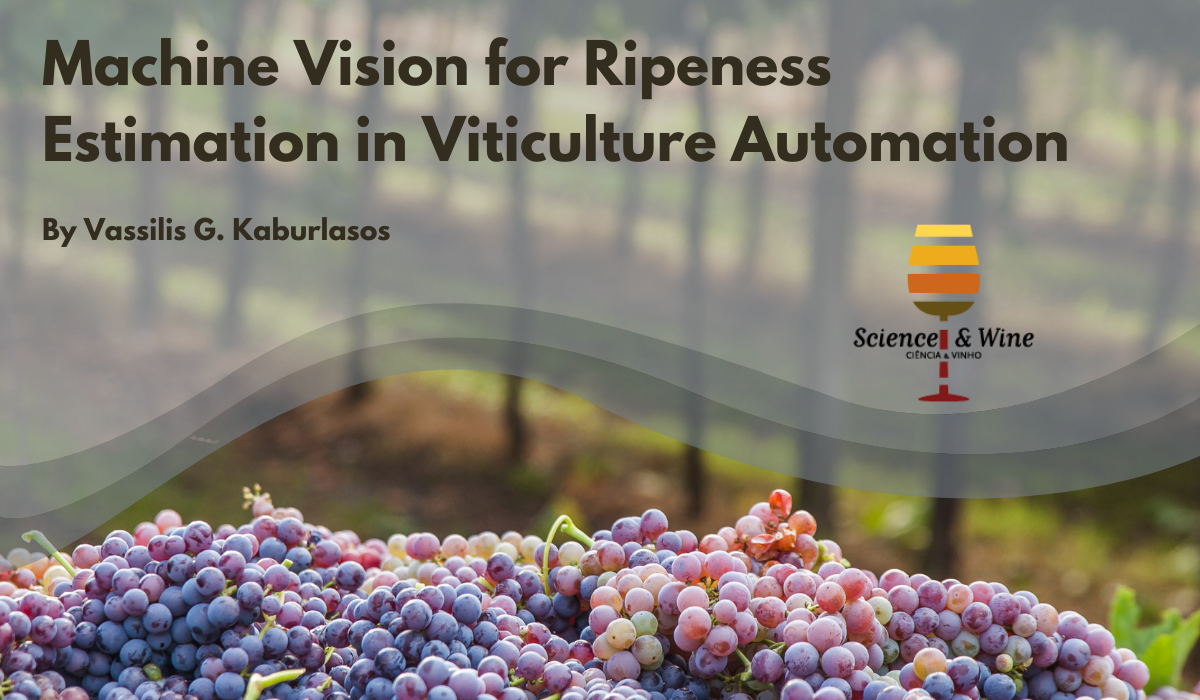
Machine Vision for Ripeness Estimation in Viticulture Automation
Ripeness estimation of fruits and vegetables is a key factor for the optimization of field management and the harvesting of the desired product quality. Typical ripeness estimation involves multiple manual samplings before harvest followed by chemical analyses. Machine vision has paved the way for agricultural automation by introducing quicker, cost-effective, and non-destructive methods. This work comprehensively surveys the most recent applications of machine vision techniques for ripeness estimation. Due to the broad area of machine vision applications in agriculture, this review is limited only to the most recent techniques related to grapes. The aim of this work is to provide an overview of the state-of-the-art algorithms by covering a wide range of applications. The potential of current machine vision techniques for specific viticulture applications is also analyzed. Problems, limitations of each technique, and future trends are discussed. Moreover, the integration of machine vision algorithms in grape harvesting robots for real-time in-field maturity assessment is additionally examined.

Influence of Climate on Soil and Wine Bacterial Diversity on a Vineyard in a Non-traditional Wine Region in Argentina
Argentina is the fifth world-wide wine producer, with an area of emerging importance in the Southwest of Buenos Aires Province, where climatic conditions are rather challenging. The authors of this post studied the variations in soil and wine bacterial diversity through three consecutive vintages, and how climatic conditions affected said diversity. During the years of the study there were two harsh climatic events, a prolonged drought that extended over two vegetative periods, and an unseasonable spring frost in 2017. The authors found that the bacterial diversity reacted to these climatic events, given that there was a shift in the taxa exclusive to soil and wine, and shared by both, through time. The results show a core of microorganisms in soil as well as in wine, belonging to different phyla that are conserved across the vintage years. A trend to an enrichment in Actinobacteria was detected in soil samples, whereas a high relative abundance of the Acetobacteraceae family and a scarcity of Lactic Acid Bacteria (LAB) were detected in the wine samples. The results of the study contribute to a better understanding of the impact of climatic conditions on the soil and wine microbiota and can provide vintners with valuable knowledge for improving their wine production.
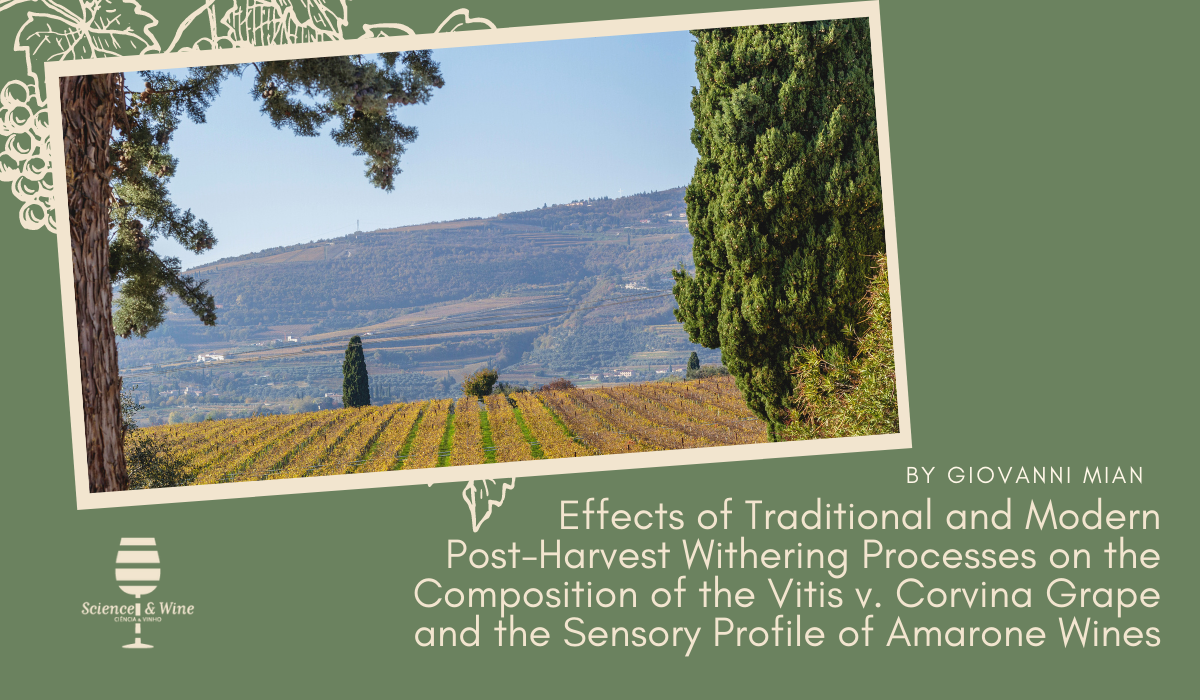
Effects of Traditional and Modern Post-Harvest Withering Processes on the Composition of the Vitis v. Corvina Grape and the Sensory Profile of Amarone Wines
In the Valpolicella area (Verona, Italy) Vitis vinifera cv. Corvina is the main grape variety used to produce Amarone wine. Before starting the winemaking process, the Corvina grapes are stored in a withering (i.e., dehydrating) warehouse until about 30% of the berry weight is lost (WL). This practice is performed to concentrate the metabolites in the berry and enrich the Amarone wine in aroma and antioxidant compounds. In compliance with the guidelines and strict Amarone protocol set by the Consorzio of Amarone Valpolicella, withering must be carried out by setting the grapes in a suitable environment, either under controlled relative air humidity (RH) conditions and wind speed (WS)—no temperature modification is to be applied—or, following the traditional methods, in non-controlled environmental conditions. In general, the two processes have different dehydration kinetics due to the different conditions in terms of temperature, RH, and WS, which affect the accumulation of sugars and organic acids and the biosynthesis of secondary metabolites such as stilbenes and glycoside aroma precursors. For this study, the two grape-withering processes were carried out under controlled (C) and non-controlled (NC) conditions, and the final compositions of the Corvina dried grapes were compared also to evaluate the effects on the organoleptic characteristics of Amarone wine. The findings highlighted differences between the two processes mainly in terms of the secondary metabolites of the dried grapes, which affect the organoleptic characteristics of Amarone wine. Indeed, by the sensory evaluation, wines produced by adopting the NC process were found more harmonious, elegant, and balanced. Finally, we can state how using a traditional system, grapes were characterised by higher levels of VOCs (volatile compounds), whilst wines had a higher and appreciable complexity and finesse.
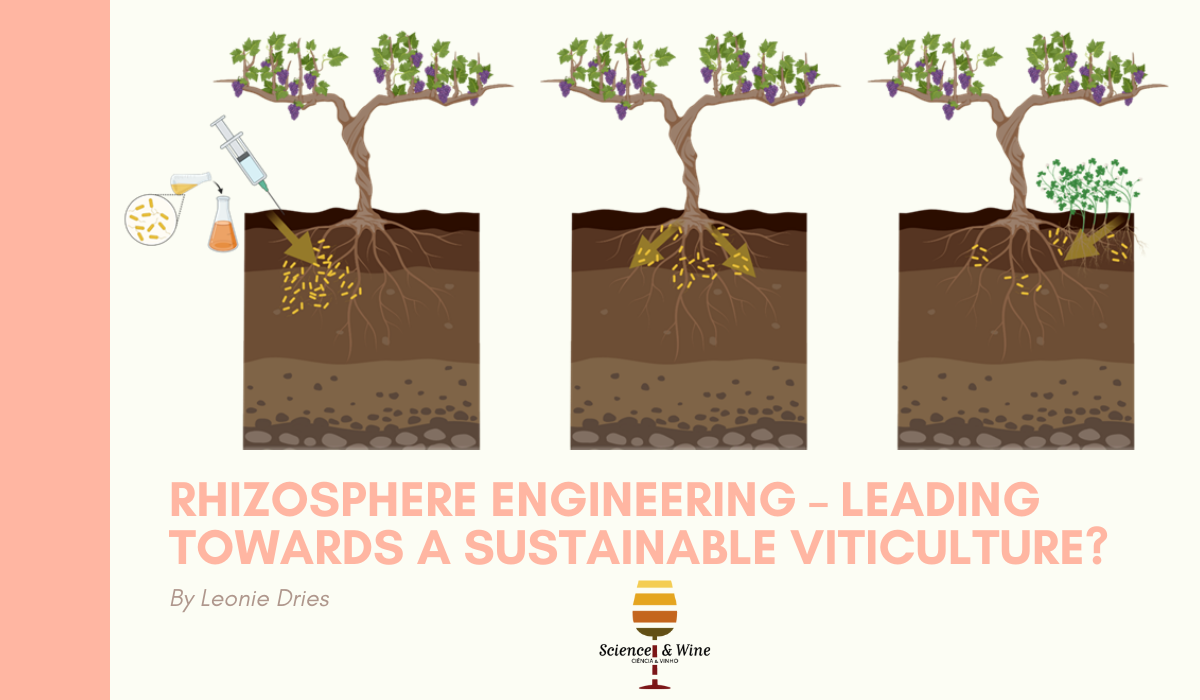
Rhizosphere engineering – leading towards a sustainable viticulture?
Microorganisms are a substantial component of the rhizosphere, and the activity and composition of rhizosphere microbial populations markedly affect interactions between plants and the soil environment. In addition, the microbiota of the rhizosphere can positively influence plant development, growth and vitality. In vineyards, management practices influence both grapevine root growth directly and the rhizosphere microbiota, but the exact mode of action is largely unknown. Recently, however, two new research approaches are increasingly coming into focus to enhance grapevine growth and health: plant engineering and rhizosphere engineering. In plant engineering, knowledge about plant-microbiome interactions is used for plant breeding strategies. In rhizosphere engineering, microbial communities are modified by adding specific fertilisers, nutrients or by bio-inoculation with certain bacteria and/or fungi. Taken together, these new methods suggest a potential for reaching a more sustainable development of pesticide-reduced viticulture in the future.

Increasing the use of mechanized grape harvesting
Due to the low number of employees and the time limit in the field of grape harvesting, the authors presented in this post the results of an evaluation of the effectiveness of the deployment of an outboard grape harvester within the conditions of Slovak viticulture. The post evaluates the dependence of the use of mechanized harvesting on changes in the purchase price of grapes (increasing it also exponentially increases the required area) and on changing the hourly wage of an employee (increasing it degressively reduces the required area). From the results it can be said that statistically and economically significant outputs were achieved for the deployment of machine collection.
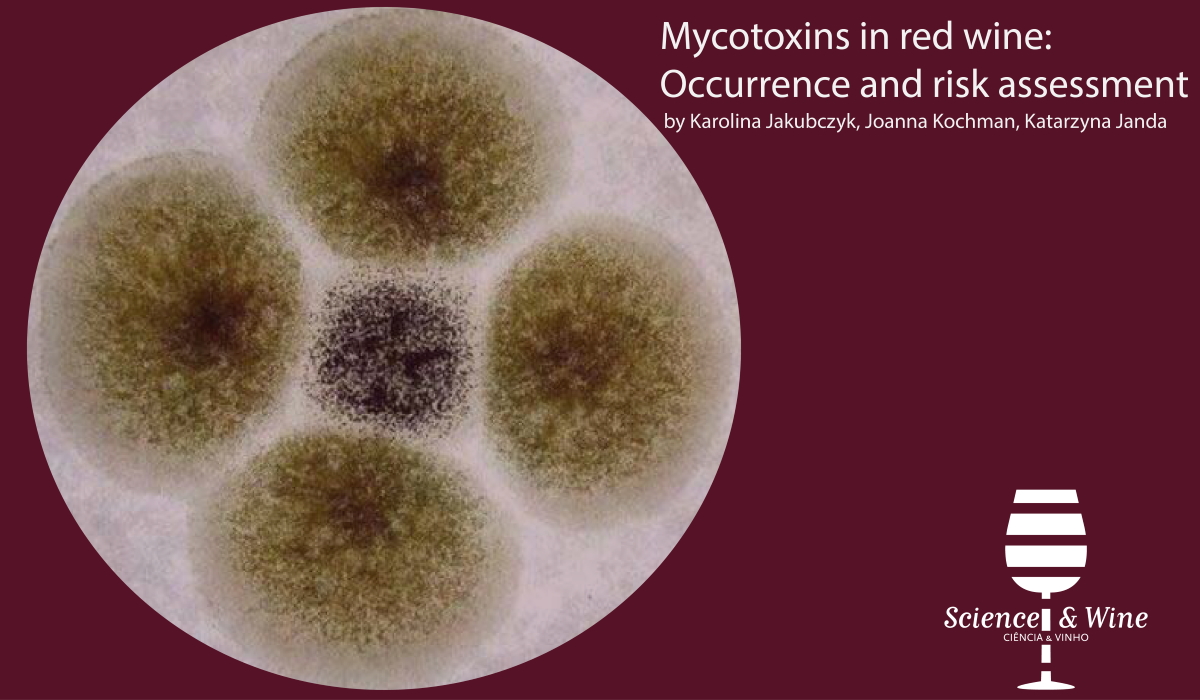
Mycotoxins in red wine: Occurrence and risk assessment
Mycological contamination of food products is a common problem in the food industry, associated with implications for consumer health. Red wine is regarded as an alcoholic beverage with health benefits, notably for the circulatory system. However, in spite of its health-promoting properties, it can also be a source of toxic substances. Wine is a documented source of ochratoxin A, which is one of the ubiquitous, highly toxic secondary metabolites produced by filamentous fungi. It is the only mycotoxin for which a regulatory maximum level in wine has been established. There are no legal regulations on the content of other mycotoxins in wine, as a product with an increased risk of mycological contamination, and so their levels are not monitored. The aim of this study was to determine the concentrations of ochratoxin A (OTA), deoxynivalenol (DON) as well as T-2 and HT-2 toxins in dry red wines.

What do you know about grapevine epigenetics? Results from Malbec, the star Argentinean variety
Clonal selection and vegetative propagation determine low genetic variability in grapevine cultivars, although it is common to observe diverse phenotypes. Environmental signals may induce epigenetic changes altering gene expression and phenotype. The range of phenotypes that a genotype expresses in different environments is known as phenotypic plasticity. DNA methylation is the most studied epigenetic mechanism, but only few works evaluated this novel source of variability in grapevines. In the present study, authors analyzed the effects on phenotypic traits and epigenome of three Vitis vinifera cv. Malbec clones cultivated in two contrasting vineyards of Mendoza, Argentina

Assessing the Biofilm Formation Capacity of the Wine Spoilage Yeast Brettanomyces bruxellensis through FTIR Spectroscopy
Brettanomyces bruxellensis is a wine spoilage yeast known to colonize and persist in production cellars. However, knowledge on the biofilm formation capacity of B. bruxellensis remains limited. The present study investigated the biofilm formation of 11 B. bruxellensis strains on stainless steel coupons after 3 h of incubation in an aqueous solution. FTIR analysis was performed for both planktonic and attached cells, while comparison of the obtained spectra revealed chemical groups implicated in the biofilm formation process.This study represents the first to succeed at applying a non-invasive technique to reveal the metabolic fingerprint implicated in the biofilm formation capacity of B. bruxellensis, underlying the homogenous mechanism within the yeast species.

Transcriptional, hormonal, and metabolic changes in susceptible grape berries under powdery mildew infection
Vitis vinifera berries are extremely sensitive to infection by the biotrophic pathogen Erysiphe necator causing powdery mildew disease and deleterious effects on grape and wine quality. The combined analysis of the transcriptome and metabolome associated with this common fungal infection has not been previously carried out in any fruit. In order to identify the molecular, hormonal and metabolic mechanisms associated with infection, healthy and naturally infected Carignan berries were collected at two developmental stages: late green (EL33) and early véraison (EL35).

